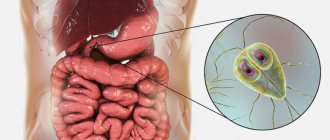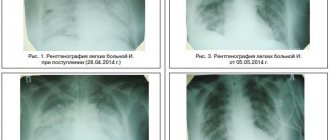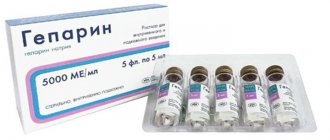Reaferon EC-LIPINT lyophilisate for children, bottles 250 thousand IU No. 5
A country
Russia
The country of production may vary depending on the batch of goods. Please check with the operator for detailed information when confirming your order.
Active substance
Interferon alpha-2
Compound
Recombinant human interferon alpha.
pharmachologic effect
Pharmacological action - antiviral, immunomodulatory, antitumor, antiproliferative. Prevents viral infection of cells, changes the properties of the cell membrane, prevents adhesion and penetration of the virus into the cell. Initiates the synthesis of a number of specific enzymes, disrupts the synthesis of viral RNA and viral proteins in the cell. Changes the cytoskeleton of the cell membrane, metabolism, preventing the proliferation of tumor (especially) cells. It has a modulating effect on the synthesis of some oncogenes, leading to normalization of neoplastic cell transformation and inhibition of tumor growth. Stimulates the process of antigen presentation to immunocompetent cells, modulates the activity of killer cells involved in antiviral immunity. When administered intramuscularly, the rate of absorption from the injection site is uneven. The time to reach maximum concentration in plasma is 4-8 hours. 70% of the administered dose is distributed in the systemic circulation. Half-life is 4-12 hours. It is excreted mainly by the kidneys by glomerular filtration.
Indications for use
Hairy cell leukemia, chronic myeloid leukemia, viral hepatitis B, active viral hepatitis C, primary (essential) and secondary thrombocytosis, transitional form of chronic granulocytic leukemia and myelofibrosis, multiple myeloma, kidney cancer; AIDS-related Kaposi's sarcoma, mycosis fungoides, reticulosarcoma, multiple sclerosis, prevention and treatment of influenza and acute respiratory viral infection.
Interaction
Disturbs the metabolism of cimetidine, phenytoin, warfarin, theophylline, diazepam, propranolol.
Side effect
Lethargy, fever, chills, loss of appetite, muscle pain, headache, joint pain, sweating, nausea, vomiting, changes in taste, dry mouth, weight loss, diarrhea, abdominal pain, constipation, flatulence, increased peristalsis, heartburn, liver dysfunction, hepatitis, dizziness, visual disturbances, ischemic retinopathy, depression, drowsiness, impaired consciousness, nervousness, sleep disturbance, allergic skin reactions (rash, itching).
Contraindications
Hypersensitivity, severe heart disease (including a history), acute myocardial infarction, severe dysfunction of the liver, kidneys or hematopoietic system, epilepsy and/or other disorders of the central nervous system; chronic hepatitis against the background of decompensated cirrhosis of the liver; chronic hepatitis in patients receiving or recently receiving immunosuppressant therapy (with the exception of short-term pre-treatment with steroids). Restrictions on use: Pregnancy, breastfeeding (breastfeeding should be stopped), childhood.
Overdose
No information available.
special instructions
Combinations with drugs acting on the central nervous system and immunosuppressants should be avoided. Throughout the course, it is necessary to monitor the content of blood cells and liver function. To mitigate side effects (flu-like symptoms), simultaneous administration of paracetamol is recommended.
Dispensing conditions in pharmacies
On prescription
Reaferon-ES-Lipint® Lyophilisate, bottle, 6 pcs., 500,000 IU, for suspension preparation
Directions for use and doses
It is administered orally. Immediately before use, add 1-2 ml of distilled or cooled boiled water to the contents of the bottle. Shaking for 1-5 minutes should form a homogeneous suspension. For acute hepatitis B, the drug is taken 30 minutes before meals according to the following scheme:
- adults and school-age children - but 1 million IU 2 times a day for 10 days;
- children of preschool age (from 3 to 7 years) - 500 thousand IU 1 time / day for 10 days or. after control biochemical blood tests, for a longer period until complete clinical recovery.
For chronic hepatitis B in active and inactive replicative forms, as well as for chronic hepatitis B associated with glomerulonephritis, the drug is taken 30 minutes before meals according to the following scheme:
- adults and school-age children - 1 million IU 2 times/day for 10 days and then for 1 month - every other day, 1 time/day (at night);
- children of preschool age (from 3 to 7 years) - but 500 thousand IU 2 times / day for 10 days and then - 500 thousand IU for 1 month every other day, 1 time / day (at night).
When carrying out specific immunotherapy, the drug is taken in the morning, 30 minutes after meals. according to the following scheme:
- for allergic rhinoconctivitis in adults - 500 thousand IU daily for 10 days (course dose 5 million IU);
- for atonic bronchial asthma in adults - but 500 thousand IU 1 time / day for 10 days, and then 500 thousand IU every other day for 20 days. The total duration of treatment is 30 days.
For the prevention and treatment of influenza and ARVI, the drug is taken 30 minutes before meals:
- for prevention: adults and children over 15 years old - 500 thousand IU 1 time / day 2 times a week for 1 month during an increase in incidence; children from 3 to 15 years old, 250 thousand IU 1 time / day, 2 times a week for 1 month during an increase in incidence;
- for the treatment of influenza and ARVI: adults and children over 15 years old - 500 thousand IU daily 2 times a day for 3 days: children from 3 to 15 years old - 250 thousand IU daily 2 times a day for 3 days.
For complex therapy of urogenital infections in adults, the drug is taken 30 minutes before meals, 500 thousand IU daily, 2 times a day for 10 days. For complex therapy of tick-borne encephalitis, the drug is taken 30 minutes before meals:
- for febrile form: 500 thousand IU 2 times a day (morning and evening) for 7 days;
- for the meningeal form: 500 thousand IU 2 times a day (morning and evening) for 10 days.
For emergency prevention of tick-borne encephalitis, the drug is taken 30 minutes before meals, 500 thousand IU 2 times a day (morning and evening) for 5 days. Anti-tick immunoglobulin is administered intramuscularly once no later than the 4th day after the tick bite at a dose of 0.1 ml/kg.
special instructions
For diseases of the thyroid gland, the use of the drug should be carried out under the supervision of an endocrinologist. If signs of thyroid dysfunction appear during therapy, it is recommended to monitor the concentration of thyroid-stimulating hormone (TSH).
During the period of use of the drug, patients experiencing fatigue, drowsiness or disorientation should refrain from engaging in potentially hazardous activities that require increased concentration and speed of psychomotor reactions.
Indications for use
As part of complex therapy:
- acute hepatitis B;
- chronic hepatitis B in active and inactive replicative forms, as well as chronic hepatitis B complicated by glomerulonephritis;
- atopic diseases, allergic rhinoconjunctivitis, bronchial asthma during specific immunotherapy;
- urogenital chlamydial infection in adults;
- febrile and meningeal forms of tick-borne encephalitis in adults.
- emergency prevention of tick-borne encephalitis in combination with anti-tick immunoglobulin.
Prevention and treatment of influenza and ARVI in adults and children.
Reaferon-EC Lipint lyof for the preparation of suspension for internal use 500000ME N 6
Trade name: Reaferon-ES-Lipint®
Generic name: interferon alpha-2b
Dosage form:
Lyophilisate for the preparation of a suspension for oral administration.
Compound:
One bottle contains: active substance – 250 thousand IU, 500 thousand IU or 1 million IU of human recombinant Interferon alpha-2b; excipients: sodium chloride - 8.01 mg, sodium hydrogen phosphate dodecahydrate - 4.52 mg, sodium dihydrogen phosphate dihydrate - 0.56 mg, Lipoid C 100 (phospholipids [mixture with a percentage of phosphatidylcholine of at least 94%]) - 41.18 mg, cholesterol - 4.53 mg, alpha-tocopherol acetate - 0.56 mg, lactose monohydrate - 91.34 mg.
Pharmacotherapeutic group: cytokine.
Immunobiological and pharmacological properties
Has immunomodulatory and antiviral effects.
Human recombinant interferon alpha-2b, which is the active ingredient in the drug, is synthesized by bacterial cells of the Escherichia coli strain SG-20050/pIF16, into the genetic apparatus of which the human interferon alpha-2b gene is integrated. It is a protein containing 165 amino acids and is identical in characteristics and properties to human leukocyte interferon alpha-2b.
The antiviral effect of interferon alpha-2b manifests itself during the period of virus reproduction through active inclusion in the metabolic processes of cells. Interferon alpha-2b, interacting with specific receptors on the surface of cells, initiates a number of intracellular changes, including the synthesis of specific cytokines and enzymes (2-5-adenylate synthetases and protein kinases), the action of which inhibits the formation of viral protein and viral ribonucleic acid in the cell.
The immunomodulatory effect of interferon alpha-2b is manifested in an increase in the phagocytic activity of macrophages, an increase in the specific cytotoxic effect of lymphocytes on target cells, a change in the quantitative and qualitative composition of secreted cytokines; changes in the functional activity of immunocompetent cells; changes in the production and secretion of intracellular proteins.
Indications for use
Complex therapy for patients with acute hepatitis B, chronic hepatitis B in active and inactive replicative forms, as well as chronic hepatitis B complicated by glomerulonephritis.
Treatment of patients with atopic diseases, allergic rhinoconjunctivitis, bronchial asthma during specific immunotherapy.
Prevention and treatment of influenza and ARVI in adults and children.
Complex therapy of urogenital chlamydial infection in adults.
Complex therapy of febrile and meningeal forms of tick-borne encephalitis in adults.
Emergency prevention of tick-borne encephalitis in combination with anti-tick immunoglobulin.
Contraindications
- Hypersensitivity to interferon or any other components of the drug;
- severe forms of allergic diseases;
- lactase deficiency, lactose intolerance, glucose-galactose malabsorption;
- pregnancy and breastfeeding.
Carefully:
Liver and/or renal failure, severe myelosuppression, thyroid disease.
Use during pregnancy and breastfeeding
The drug is contraindicated for use during pregnancy and breastfeeding.
Directions for use and doses
It is administered orally.
Immediately before use, add 1-2 ml of distilled or cooled boiled water to the contents of the bottle. Shaking for 1-5 minutes should form a homogeneous suspension.
For acute hepatitis B, the drug is taken 30 minutes before meals according to the following scheme:
- adults and school-age children - 1 million IU 2 times a day for 10 days;
- children of preschool age (from 3 to 7 years) - 500 thousand IU 1 time per day for 10 days or, after control biochemical blood tests, for a longer time - until complete clinical recovery.
For chronic hepatitis B in active and inactive replicative forms, as well as for chronic hepatitis B associated with glomerulonephritis, the drug is taken 30 minutes before meals according to the following scheme:
- adults and school-age children - 1 million IU twice a day for 10 days and then for 1 month - every other day, once a day (at night);
- children of preschool age (from 3 to 7 years) - 500 thousand IU twice a day for 10 days and then - 500 thousand IU for 1 month every other day, once a day (at night).
When carrying out specific immunotherapy, the drug is taken in the morning, 30 minutes after meals, according to the following scheme:
— for allergic rhinoconjunctivitis in adults – 500 thousand IU daily for 10 days (course dose 5 million IU);
- for atopic bronchial asthma in adults - 500 thousand IU once a day for 10 days, and then 500 thousand IU every other day for 20 days. The total duration of treatment is 30 days.
For the prevention and treatment of influenza and ARVI, the drug is taken 30 minutes before meals:
— for prevention: adults and children over 15 years old — 500 thousand IU once a day, 2 times a week for 1 month during an increase in incidence; children from 3 to 15 years old - 250 thousand IU once a day, 2 times a week for 1 month during an increase in incidence.
— for the treatment of influenza and ARVI: adults and children over 15 years old – 500 thousand IU daily, 2 times a day for 3 days; children from 3 to 15 years old - 250 thousand IU daily, 2 times a day for 3 days.
For complex therapy of urogenital infections in adults, the drug is taken 30 minutes before meals, 500 thousand IU daily, 2 times a day for 10 days.
For complex therapy of tick-borne encephalitis, the drug is taken 30 minutes before meals:
- for febrile form: 500 thousand IU 2 times a day (morning and evening) for 7 days;
— for the meningeal form: 500 thousand IU 2 times a day (morning and evening) for 10 days;
For emergency prevention of tick-borne encephalitis, the drug is taken 30 minutes before meals, 500 thousand IU 2 times a day (morning and evening) for 5 days. Anti-tick immunoglobulin is administered intramuscularly once no later than the 4th day after the tick bite at a dose of 0.1 ml/kg.
Side effect
When using the drug Reaferon-ES-Lipint® in clinical studies, no adverse reactions to the drug were observed. Considering that the active ingredient is recombinant interferon alpha-2b, when using the drug Reaferon-ES-Lipint®, side effects characteristic of this group of drugs are possible: chills, fever, asthenic symptoms (apathy, fatigue, lethargy), headaches, myalgia , arthralgia. These side effects are partially relieved by indomethacin/paracetamol. Allergic reactions may develop.
From the digestive system: nausea, dry mouth, dyspepsia, loss of appetite.
From the nervous system: with prolonged use, irritability, anxiety, insomnia, apathy, and depression are possible.
From the endocrine system: changes in the thyroid gland are possible.
From laboratory parameters: with long-term use, leukopenia, lymphopenia, thrombocytopenia are possible.
Overdose
There were no cases of overdose. Increased dose-dependent side effects are possible. Treatment is symptomatic.
Interaction with other drugs
Interferon alpha-2b is capable of reducing the activity of cytochrome P450 isoenzymes and, therefore, interfering with the metabolism of cimetidine, phenytoin, dipyridamole, theophylline, diazepam, propranolol, warfarin, and some cytostatics. May enhance the neurotoxic, myelotoxic or cardiotoxic effects of drugs prescribed previously or simultaneously with it. Co-administration with drugs that depress the central nervous system and immunosuppressive drugs (including oral and parenteral forms of glucocorticosteroids) should be avoided.
Drinking alcohol during treatment is not recommended.
special instructions
For diseases of the thyroid gland, the use of the drug should be carried out under the supervision of an endocrinologist. When signs of thyroid dysfunction appear during therapy. It is recommended to monitor the concentration of thyroid-stimulating hormone (TSH).
Impact on the ability to drive vehicles and machinery
During the period of use of the drug, patients experiencing fatigue, drowsiness or disorientation should refrain from engaging in potentially hazardous activities that require increased concentration and speed of psychomotor reactions.
pharmachologic effect
Interferon. Immunomodulatory drug with antiviral effect.
It has a pmmu-modulating and antiviral effect. Human recombinant interferon alpha-2b, which is the active ingredient in the drug, is synthesized by bacterial cells of the strain.
Escherichia coli SG-20050/pIF16, in the genetic apparatus of which the human interferon alpha-2b gene is integrated. It is a protein containing 165 amino acids and is identical in characteristics and properties to human leukocyte interferon alpha-2b.
The antiviral effect of interferon alpha-2b manifests itself during the period of virus reproduction through active inclusion in the metabolic processes of cells. Interferon alpha-2b, interacting with specific receptors on the cell surface, initiates a number of intracellular changes, including the synthesis of specific cytokines and enzymes (2-5-adenylate synthetases and orotein kinases). the action of which inhibits the formation of viral protein and viral ribonucleic acid in the cell. The immunomodulatory effect of interferon alpha-2b is manifested in an increase in the phagocytic activity of macrophages, an increase in the specific cytotoxic effect of lymphocytes on target cells, a change in the quantitative and qualitative composition of secreted cytokines: a change in the functional activity of immunocompetent cells; changes in the production and secretion of intracellular proteins.




